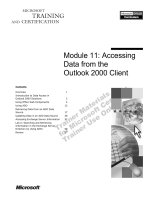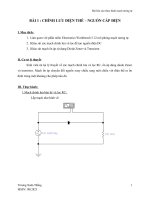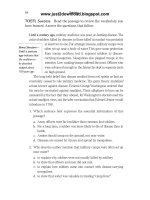Tài liệu Treatment of trade finance under the Basel capital framework ppt
Bạn đang xem bản rút gọn của tài liệu. Xem và tải ngay bản đầy đủ của tài liệu tại đây (39.16 KB, 10 trang )
Basel Committee
on Banking Supervision
Treatment of trade finance
under the Basel capital
framework
October 2011
Copies of publications are available from:
Bank for International Settlements
Communications
CH-4002 Basel, Switzerland
E-mail:
Fax: +41 61 280 9100 a
nd +41 61 280 8100
This publication is available on the BIS website (www.bis.org
).
© Bank for International Settlements 2011. All rights reserved. Brief excerpts may be reproduced or translated
provided the source is stated.
ISBN print: 92-9131-890-6
ISBN web: 92-9197-890-6
Treatment of trade finance under the Basel capital framework
Contents
Executive Summary 1
Introduction 1
Committee’s considerations regarding the issues raised 2
Leverage ratio 2
20% credit conversion factor under the risk-based measure 3
One-year maturity floor 3
Claims on banks 4
Treatment of trade finance under the Basel capital framework
Executive Summary
Following consultations with the World Bank, the World Trade Organisation and the
International Chamber of Commerce, the Basel Committee on Banking Supervision has
evaluated the impact of Basel II and III on trade finance in the context of low income
countries.
As a result of this evaluation, the Committee has adopted two changes to the treatment of
trade finance in the Basel II and III capital adequacy framework. These changes respect the
integrity of the capital framework and its broader financial stability objectives.
The changes to the capital framework agreed by the Committee are as follows:
1. waive the one-year maturity floor for certain trade finance instruments under the
advanced internal ratings-based approach (AIRB) for credit risk; and
2. waive the so-called sovereign floor for certain trade-finance related claims on banks
using the standardised approach for credit risk.
Under the current AIRB rules, capital requirements for credit exposures are subject to a
minimum maturity requirement of one year while the average tenor of trade finance
transactions is significantly less than one year. Waiving the one-year maturity floor for issued
and for confirmed letters of credit – instruments that are particularly relevant for low income
countries when they import goods – would reduce capital requirements for banks engaged in
trade finance and which use the AIRB.
The other change agreed by the Committee is relevant for banks using the standardised
approach for credit risk. When a bank confirms a letter of credit, it has an exposure to
another bank (the bank that issues the letter of credit – or the “issuing bank”). In the case of
a low income country which imports goods, the issuing bank is usually domiciled in the
importer’s country (ie the low income country) and typically does not have an external credit
rating. Under the regulatory capital framework, where the risk weights are based on the
external ratings of bank counterparties, claims on an unrated bank are subject to a risk
weighting of 50% or, in the case of short term claims, 20%. The risk weighting applied to this
bank exposure cannot, however, be lower than the risk weighting of the sovereign in which
the issuing bank is incorporated. In the case of low income countries, this is typically 100%
(the so-called “sovereign floor”). Waiving this floor to allow the risk weighting to move below
100% will help reduce capital requirements for banks engaged in trade finance and thus
foster the import of goods for low income countries.
Introduction
At its November 2010 Summit in Seoul, G20 Leaders decided “to monitor and assess trade
finance programs in support of developing countries, in particular their coverage and impact
on LICs (ie Low Income Countries), and to evaluate the impact of regulatory regimes on
trade finance.” The Committee announced in its 1 December 2010 press release that it “will
evaluate the impact of the regulatory regime on trade finance in the context of low income
countries.” To carry forward the work, the Committee established its “Trade Finance Group”
with a mandate to assess the issue in consultation with interested constituencies and to
Treatment of trade finance under the Basel capital framework
1
finalise the work prior to the November 2011 G20 Leaders’ Summit. The mandate noted that
the Trade Finance Group was to respect the integrity of core parts of the financial stability
agenda already agreed by the G20.
The Trade Finance Group has held consultations with representatives from the International
Chamber of Commerce (ICC), the World Bank (WB), and the World Trade Organisation
(WTO). It met with these organisations in February 2011 and July 2011, during which it
discussed the characteristics of trade finance products, the potential impact of Basel II and III
on trade finance and possible ways to address the issue.
Committee’s considerations regarding the issues raised
Based on the work of the Trade Finance Group, the Committee’s focus has been on
confirmed letters of credit, the most typical form of bank-intermediated contingent trade
finance products and commonly used in trade with low-income countries. While data is
scarce on the relative importance of the different types of trade credit, rough estimates based
on ICC data show that letters of credit represent approximately 20% of all trade finance
instruments but are particularly important for low-income countries.
Taking into account the focus of the Committee’s work on the impact on low-income
countries, the Committee in particular considered four main issues:
1. The 100% Credit Conversion Factor (CCF) in calculating the leverage ratio for
contingent trade finance exposures;
2. The 20% CCF under the risk-based standardised and foundation internal ratings-
based (FIRB) approaches;
3. The one-year maturity floor for trade finance under the advanced internal ratings-
based approach (AIRB); and
4. Other ways of addressing the impact of the capital requirements on low income
countries.
The Committee’s assessment of each of these issues is described below.
Leverage ratio
The Commit
tee evaluated whether the 100% CCF for contingent trade finance products in
calculating the leverage ratio is too high and whether the 100% CCF disadvantage banks
specialised in trade finance.
In principle, off-balance sheet positions are subject to a CCF when calculating the risk-based
capital adequacy measure under the Basel capital framework. The CCF reflects the
likelihood of an off-balance sheet position becoming an on-balance sheet item.
The Committee decided to not change the CCF for calculating the leverage ratio. The
calculation of the leverage ratio was intentionally designed to be simple and not based on
any differential risk weighting. For example, government bonds are included in this
calculation based on their face value. Changing the CCF for trade finance under the leverage
ratio would be inconsistent with the core financial stability objectives of the capital framework.
The leverage ratio is designed to serve as a credible supplementary measure to the risk-
2
Treatment of trade finance under the Basel capital framework
based requirement subject to appropriate review and calibration. It is intended to reinforce
the risk based requirements with a simple, non-risk based “backstop” measure. As stated in
the document A global regulatory framework for more resilient banks and banking systems
(Basel III),
1
the Committee will use the transition period to monitor banks’ leverage data on a
semi-annual basis in order to assess whether the proposed design and calibration of the
minimum Tier 1 leverage ratio of 3% is appropriate over a full credit cycle and for different
types of business models.
In the context of the 100% CCF for calculating the leverage ratio, Basel III applies a 10%
CCF to commitments that are unconditionally cancellable and it also has been argued that
such an exception could also be made for trade finance commitments. However, the 10%
CCF treatment will only be made for commitments that are unconditionally cancellable at
any time by the bank without prior notice. Those commitments are significantly different from
contingent trade finance products which are binding commitments for the respective bank, ie
they are irrevocable and cannot be cancelled without prior agreement of the beneficiary.
Undrawn unconditionally cancellable commitments to issue contingent trade finance
products will, of course, also be eligible for the 10% CCF.
20% credit conversion factor under the risk-based measure
The Committee evaluated the ca
se for lowering the 20% CCF under the Basel II
standardised and FIRB risk-based measures. The CCF is relevant for short-term self-
liquidating trade letters of credit arising from the movement of goods. Essentially, it reduces
capital requirements by 80% as compared to positions that are subject to a 100% CCF.
The current 20% CCF has been part of the Basel capital framework since their inception in
1988. The CCF expresses the likelihood of an off-balance sheet position to become on-
balance sheet, ie it is not related to the riskiness of a counterparty which is expressed by the
position’s probability of default.
In its evaluation, the Committee reviewed a credit register established by the ICC in 2010 to
pool performance data on trade finance products. Nine internationally active banks
participated in the registry. The Committee is of the view that the credit register does not
provide sufficient analytical evidence for reducing the CCF in the risk-based approach below
the currently applied 20%. In addition, the data presented is more relevant for the probability
of default of a trade finance instrument rather than its likelihood of becoming on-balance
sheet.
The Committee, however, supports further work by the ICC, as well as the WTO and WB, to
strengthen data on trade finance. It has been informed that the ICC has considerably
expanded its database of defaults on trade finance transactions and intends to publish a
report based on new data.
One-year maturity floor
In princip
le, Basel II requires banks, when calculating risk weighted assets under the AIRB,
to measure the effective maturity for each facility subject to the provision that it cannot be
1
See
Treatment of trade finance under the Basel capital framework
3
4
Treatment of trade finance under the Basel capital framework
less than one year.
2
The rules do, however, contain an exception for the one-year maturity
floor for certain short term exposures, in particular repos/reverse repos and securities
lending/securities borrowing transactions. Other transactions, among which are short-term
self-liquidating trade transactions, may also be eligible for exemption from the one-year floor,
but subject to national discretion. It has been argued that the one-year maturity floor under
the AIRB is also inappropriate for short-term self-liquidating trade finance instruments given
their average tenor of well below one year.
3
The Committee agreed, therefore, to base the
calculation on the effective maturity for transactions with a maturity of less than one year. It
believes that this should become the rule rather than an item left to national discretion.
The Committee further agreed to include, in the revised treatment, issued as well as
confirmed letters of credit which are short term (ie have a maturity below one year) and self-
liquidating. Other trade finance transactions which are not letters of credit can continue to be
exempted from the one-year floor, subject to national discretion.
Claims on banks
The Committee evaluated the impact of its r
egulatory regimes on trade finance for low
income countries. For those countries, confirmed letters of credit are of specific importance.
Confirmed letters of credit provide exporters with additional protection against any losses
incurred from importers’ and issuing banks’ failure to meet their obligations of payments. A
typical example is the export of goods to a low-income country which in almost all cases
requires a confirmed letter of credit since the exporter generally will not rely only on the
creditworthiness of the importer and its bank.
While waiving the one-year maturity floor also addresses this issue, the Committee
considered other ways to reduce capital requirements related to low income countries in the
context of trade finance transactions. It agreed to waive the so-called sovereign floor for
claims of the confirming bank on the issuing bank under option 2 of Basel II’s standardised
approach for credit risk
4
in the context of short-term self-liquidating letters of credit. Under
this approach, the exposure’s risk weighting depends on the rating of the issuing bank. The
risk weighting of an unrated bank
5
is, in principle, 50% or even 20% for short-term claims
(with an original maturity of three months or less). However, Basel II also states that the risk
weighting cannot be lower than that which is applicable to the sovereign in which the bank is
incorporated. For low-income countries,
6
this would be 100%. Thus, the preferential risk
weights for unrated banks under option 2 cannot be applied. To make access to trade
finance instruments easier and less expensive for low income countries, the Committee
agreed to waive the sovereign floor for short-term self-liquidating letters of credit. This will
allow banks to take advantage of the reduced risk weights.
2
The same methodology can be applied to banks under the FIRB, subject to national discretion. See Basel II:
International Convergence of Capital Measurement and Capital Standards: A Revised Framework -
Comprehensive Version, paragraph 318, which is accessible at www.bis.org/publ/bcbs128.htm.
3
The ICC trade finance register concludes that trade finance transactions have an average tenor of 115 days.
4
There is another option (option 1) for claims on banks under the standardised approach for credit risk which
bases the risk weighting of those claims on the rating of the sovereign of incorporation. This option is not
affected by the change.
5
Most banks in low-income countries can be assumed to be unrated.
6
Among the 40 countries defined as low income economies by the World Bank, only eight have been rated by
S&P. None of those has a rating below B If below B-, a 150% risk weighting would apply.









